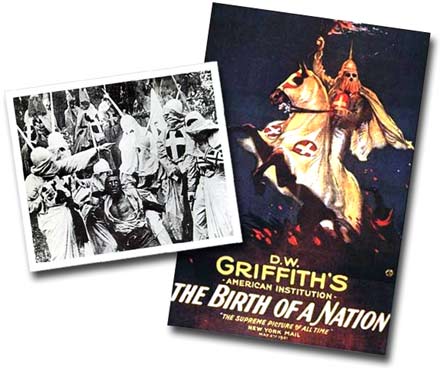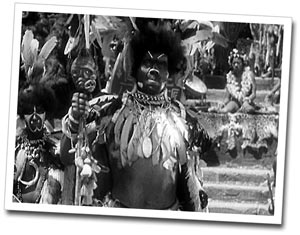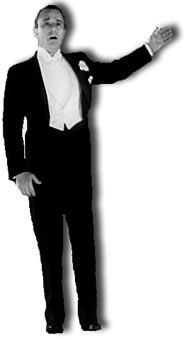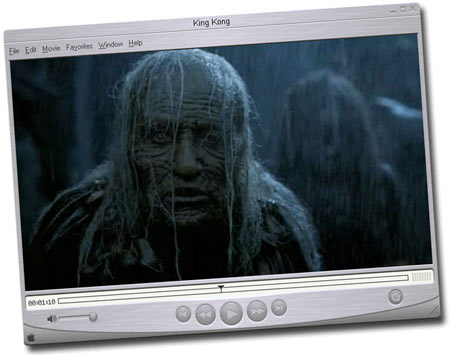
It’s been some weeks since I wrote about Merian Cooper and the new biography, “Living Dangerously,” and this much seems to be true: no installment of the Kong Files has elicited less response than that particular one. It bears mentioning because when you relate the amazing facts of Merian C. Cooper’s life to the uninitiated, a common response is: “Why haven’t I heard of this guy before?” Why, indeed? To add insult to injury, his name is misspelled on the rights page of the Underwood Books edition of the King Kong novelization.
I got a couple emails, however, regarding the issue of race in “Living Dangerously,” so I’ll finish up my discussion of the book by gingerly touching upon racial attitudes in the early 20th century—which surely inform the content of King Kong—and the nature of nonfiction as it relates to a man known to be a bit of a “fabulist” in his anecdotal retellings of his life’s adventures. One relates to the other in the way certain stories told by Cooper reveal the prevailing attitude of circa-1930
society-at-large with regard to non-Western cultures.
In his book “Things Men Die For,” Cooper championed Manifest Destiny in no uncertain terms:
The lust of power is in us, we white men. We’ll sacrifice anything for the chance to rule. And I believe that it is right that black, brown and yellow men should be dominated by the white. That was not a minority opinion in those days. Not too long before Cooper published his opinion, we claimed for ourselves under the same doctrine —without qualms—what are now gigantic portions of the central and western United States. And before that, North and Central America were taken by white Europeans who viewed the brown-skinned natives living there as tenants whose time was up. So it should be strongly noted that the racial attitudes of Merian Cooper were not at all extremist for his time—not even close to the pathology of men like Henry Ford, for example, who funded the production of a poisonous pamphlet called “The International Jew” beginning in 1920; or D.W. Griffith, whose Birth of a Nation in 1915 is a masterpiece marred by appalling depictions of Southern blacks and “heroic” Klansmen. It’s easy to be judgmental from our 21st century vantage, but the fact of the matter is that Cooper’s viewpoints—even as a Southerner—were somewhat progressive for the period and his expressions of conscious or unconscious racism were no more egregious than those of the world at large.

Cooper was well traveled, to say the least, and interacted with multiple ethnicities on a regular basis. In his writings there are instances where he conveys a relatively open-minded attitude toward the individuals and groups he’d encountered in faraway places, describing their feats and abilities in terms that, while certainly in the “noble savage” mode, are much less condescending than can be seen in other travel writing of the time. In Cooper’s book “Grass,” for instance, the minor khan Haidar, leader of the Baba Achmedi tribe, is described by Cooper as a “loafer, brute and robber” while in camp, but once he sees him in action during the climatic treacherous river traverse (“eight times—that I counted—he swam that river in one day”), Cooper proclaims that Haidar is “here, in danger, a man, by Glory!” The color of Haider’s skin has nothing to do with Cooper’s proclamation; rather, he has judged him based on the contrast between this feat and his past behavior, irrespective of racial background. It is almost impossible for a 21st century reader to grasp the novelty of a travel writer describing the good and bad in a third-world man in terms that could be applied as equally to a white denizen of Brooklyn.
Even more significant is another passage in the same section. All of the tribe’s animals—horses, sheep, cows, and donkeys—swam the river during the crossing. Goats, however, don’t swim, and had to be floated across on rafts like the women and children. “We crossed like the goats,” Cooper writes self effacingly, acknowledging to some extent (by not mentioning the camera equipment they needed to secure on the rafts) the Americans’ dependence on the tribesmen. Or, as Cynthia Erb writes (much more stridently) in her excellent book “Tracking King Kong,” “a position of feminized, animal-like dependency.”
Yet, as Erb further observes, Cooper cannot resist describing Haidar’s “bulging triceps” which make “his arms hang out in gorilla fashion from his shoulders” (a chapter of “Grass” is actually titled “He Had Arms Like a Gorilla!”). One could argue that Erb is being overly sensitive here, but she also points out that Cooper’s descriptions of wealthy Western-educated khans in the same region—Haidar could not speak English—never incorporate primate or animal imagery. He is, in fact, quite impressed by the English-speaking khans’ lavish hospitality and articulate manner—attributable, Erb suggests, to his Southern upbringing and its strong sense of class differences.
From Cooper’s book, “Grass.” Ernest Schoedsack, Lufta (son of Haidar), Haidar, and Merian Cooper. |
As an example of unconscious racism, it certainly does not hold a candle to something like Harry Carey’s titular character in 1931’s Trader Horn—another film in which black natives fetishize a blond pale woman, by the way—when he complements his black guide moments before their apparent execution by saying, in effect, that he was brave enough to be an honorary white man. And Trader Horn is the good guy in this flick!
And consider this: Grass (the documentary Cooper shot with Ernest Schoedsack and Marguerite Harrison) was filmed in the region now known as Iran—and we currently entertain some pretty stiff stereotypes of our own regarding the people there (i.e. we may not think of them as gorillas, but we pretty much think they are all guerillas).
Some of the stories related in “Living Dangerously,” unquestionably betray a dated sense of race that is characteristic of the times. Consider the following stunner, which I’ve read and heard in different forms over the years: while in Siam filming Chang, Cooper needed tigers to film and learned one had been trapped in a nearby village. By the time he’d arrived there, the tiger had somehow escaped. Furious, he confronted and slapped the village chief. Incredibly, Cooper then accepted the chief’s invitation to dinner, where his wife cooked a chicken dish full of “these little bamboo cuts” designed to kill him. A few days of soft bananas, he claims, saved him.
And another episode from the making of The Four Feathers, this time quoted directly from “Living Dangerously” (and, you will note, related unquestioningly as fact rather than as a Cooper anecdote):
Cooper discovered that the native helpers he’d recruited from two nearby villages had inexplicably gone home. He didn’t tell Monte [Ernest Schoedsack] or Ruth [Rose], but, furious, went alone to the villages armed only with a bullwhip made of rhinoceros hide. Seemingly forgetting the painful consequences of the slap he’d given the native chief in Siam, he stormed into the villages and lashed every native he could find. He reasoned that charging in with gunbearers would have gotten him a spear in the back but a fearless man alone would put the fear into the natives, and win back his help. Whatever his logic, the chastened villagers returned to work and helped trap the hippos. True or not, these stories—both related by Cooper to interviewers—are extremely instructive regarding prevailing attitudes toward “primitive savage cultures” in the early part of the 20th century. In the first “slapping” anecdote, we’re asked to accept a scenario wherein Cooper, evidently alone, feels comfortable expressing his anger with the leader of a village by actually striking him with an open palm, almost as if chastening a child (in some retellings, this is done in front of the chief’s subjects). The chief, rather than react with immediate personal retribution (which could have been—indeed, perhaps should have been, insofar as the chief’s responsibility to his station—deadly), leaves it to his wife to take revenge in an extremely passive, and ultimately comically ineffective, manner (Cooper is saved by “soft bananas”?).
The second tale is even more mind-boggling, and Cooper has to be considered the primary source because he mentions that he didn’t tell his companions of his whip-wielding foray. The very idea that Cooper assumed that “punishment” could be meted out indiscriminately to any villager he happened to come across in order to send a message to the specific tardy workers is astounding—as is the idea that Cooper’s main concern was getting “a spear in the back.” The implication is clear; certainly none of these “savages” would dare stand his ground and face Cooper down, or, at the very least, treat him to a spear in the front.
But, once again, I emphasize the fact that these attitudes were certainly not unique to Cooper and indeed reflect those of society in general at the time.

Why is this relevant to us? Because the basic, by now canonical storyline in the original King Kong is a product of the era in which it was created (I discuss this to some extent in Column 7: Going Native). The narrative is so compact because Cooper, Rose, Creelman, et.al. never have to waste time with explanations for what amounted to foregone conclusions in 1933: of course the ape will prefer the pale blonde; naturally the natives will flee until emboldened by the example of the white men; by all means riddle the giant beast with machine gun fire if he gets out of hand. And coconut bras? Why not! These viewpoints were pretty much universal in 1932; if anyone involved in the production raised an objection, it has never been noted or mentioned in any of the material to which I’ve been privy. And you may be the most enlightened person on your block in the here and now, but I can virtually guarantee that the 1932 version of you would not likely raise your hand in protest at an RKO production meeting (“Mr. Selznick, isn’t it demeaning for Driscoll to raise his hand as if to strike Charlie the Chinese Cook when annoyed with him?”).
 |
The character of Carl Denham is also a reflection of the times. He is painted as, at worse, an over-enthusiastic showman. At the end of the film there seems to be no overt animosity toward the man who instigated such destruction—completely in the name of financially enriching himself—at the hands of a giant ape. You almost sense awe and pity for him in the murmurs of the crowd as he approaches Kong’s corpse to deliver his famous—and comically self-absolving—line about Beauty killing the Beast. No one in the world of 1933 could blame him for grabbing opportunity by the scruff of the neck! It’s only in Son of Kong that we see Denham experiencing any sort of introspection or comeuppance. Different times, to say the least.
Therefore, bringing the story into what we could optimistically call “a more enlightened era” is a definite challenge, especially if you want to maintain the naïve pulp charm of the original tale. For example, in an update like the “Kong: King of Skull Island” book by Joe DeVito and Brad Strickland, which is designed to be as consistent as possible with the original narrative, those hypersensitive to issues of race and traditional patterns of depicting non-Western cultures can squint hard and find old tropes unconsciously resurrected and reinforced. Despite a “rehabilitation” of the Skull Island tribe (which a fellow Kong geek has gloomily characterized as “a vaguely New Age-ish ‘apology’ for the fierce, primal ‘keepers of the shrine’ in the original”), it’s explained offhandedly that native female sacrifices simply “died of fright,” while Ann Darrow is evidently further evolved and therefore impervious to this “fright death.” The islanders become inert nonentities in the sections of the book set in 1957, apparently unable to change their situation in the slightest post-1933 or even interpret their own ancient language and art until salvation is delivered unto them from the civilized world in the form of two Denhams. For the most part—with the exception of an ancient golden age—the native population of the DeVito/Strickland Skull Island seems passive and incapable of independent action, and virtually all of the events that change their destiny are instigated by the visitations of white men from “out there”—which is inconsistent, to say the least, with their bold foray to kidnap Ann Darrow in the main canonical Kong story. Despite efforts to broaden the natives’ characterization for the 21st century, these are echoes of a story spawned in the 1930s, a product of the world as it once was.

So it’ll be interesting to see how Peter Jackson and company take a film story that is so clearly dated and bring it forward without “Dwan-ing” the whole affair. Early clips show us a native population that is much different than anything we’ve seen before—satisfyingly creepy, to say the least, and of indeterminate race. We must keep in mind that this version of the tale will carry over into kids books and toys as well, so Jackson’s “creepy natives” solution may be a good way to circumvent the issue of race altogether without succumbing completely to political correctness.
Until next time, hang on tight to the log …
(Writer John Michlig's online article KING KONG: LOST AND FOUND can be seen at http://www.skullisland.net/KongBoomer.html. He's currently working with filmmaker James Mansfield on a documentary entitled EIGHTH WONDER: THE AMAZING TRUE STORY OF CARL DENHAM AND THE BEAST-GOD OF SKULL ISLAND, the startling details of which he promises to share in the very near future.)
THE KONG FILES and contents are © 2004-2006 John Michlig and written for KongisKing.net, subsidary of The One Ring®, Inc.
|






